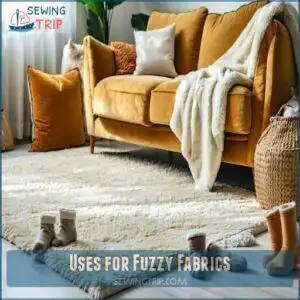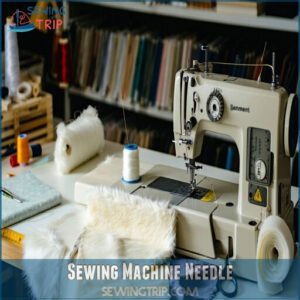This site is supported by our readers. We may earn a commission, at no cost to you, if you purchase through links.
 You’re looking for fuzzy fabric types names – let’s break it down.
You’re looking for fuzzy fabric types names – let’s break it down.
Fuzzy fabrics include pile and napped fabrics like chenille, velour, and velvet.
These fabrics are soft, comfortable, and cozy, making them perfect for clothing, upholstery, and home decor.
You’ll also find fuzzy fabrics in rugs, accessories, and more.
As you explore fuzzy fabric types names, you’ll discover a world of textures and uses – and we’re just getting started on uncovering the best ways to work with these unique materials.
Table Of Contents
Key Takeaways
- You’ll discover that fuzzy fabrics include pile and napped fabrics like chenille, velour, and velvet, which are soft, comfortable, and cozy, making them perfect for clothing, upholstery, and home decor.
- When working with fuzzy fabrics, you’ll need to consider special sewing techniques, such as using a rotary cutter, a walking foot, and a sharp needle, to achieve the best results and prevent fraying or distortion.
- You’ll find that caring for fuzzy fabrics requires gentle washing, drying, and lint removal to preserve their softness and prevent damage, and it’s essential to follow care labels and use mild soap to maintain their quality.
- You can use fuzzy fabrics to create a variety of items, including clothing, furniture, and rugs, and by choosing the right type of fuzzy fabric, you can add warmth, comfort, and style to your projects, making them perfect for cool nights or cozy spaces.
What is Fuzzy Fabric?
You’re about to learn what fuzzy fabric is and how it’s made.
Fuzzy fabrics, including pile and napped fabrics, are soft, comfortable, and cozy, making them ideal for various uses, from clothing to home decor.
Pile Fabrics
You’ll love pile fabrics, featuring fabric loops that create a fuzzy texture.
Pile construction gives velvet, velour, and corduroy their plush surfaces and soft fibers, making them perfect examples of fuzzy fabrics with a unique touch.
Understanding different types of knit fabrics can also help in identifying various textile characteristics and improve your knowledge of fuzzy fabrics.
Napped Fabrics
You’re exploring napped fabrics, which have a special finish for a warmer feel.
Fabric brushing creates a soft, fuzzy surface. Napped fabrics, like velvet and corduroy, differ from pile fabrics in texture.
They offer soft finishes and varying pile heights, making them unique among fuzzy fabrics, including plush and velvet fabrics.
Common Types of Fuzzy Fabric
You’re about to discover the wonderful world of fuzzy fabrics, and it’s key to know the common types.
As you explore these fabrics, you’ll find popular options like Chenille, Velour, and Fur, each with unique characteristics and uses.
Chenille
You’re now exploring chenille, a soft fabric with a fuzzy texture, created by looping chenille yarn to form a loop pile, making it a popular choice for clothing and home decor.
It requires special chenille care to maintain its softness and durability, similar to velour and velvet fabrics.
For more information, explore various fuzzy fabric types and names.
Velour
Velour is a fuzzy fabric known for its plush pile and soft finish.
It’s often confused with velvet and velveteen, but velour has a unique fabric weave creating a distinctive velour texture.
This results in a luxurious feel, with a fuzzy yarn that’s perfect for plush textures.
Consider these benefits of velour:
- It drapes beautifully, making it ideal for elegant garments.
- The soft finish against your skin feels incredibly luxurious.
- Its rich color absorption makes velour visually stunning.
Fur
You’re considering fur, a fuzzy fabric made from animal hides or synthetic fibers, like faux fur fabric.
Fur coats and fur trim add luxury, while synthetic fur offers a more affordable option, similar to sherpa fabric, but with a softer, more velour-like texture, making it a popular choice.
Uses for Fuzzy Fabrics
You can use fuzzy fabrics to create a variety of items, including clothing, furniture, and rugs.
By choosing the right type of fuzzy fabric, you can add warmth, comfort, and style to your projects, making them perfect for cool nights or cozy spaces.
Clothing
Where do you turn when the cold creeps in? Fuzzy fabrics, of course! They’re the perfect choice for crafting cozy and warm clothing.
From sweaters to coats and blankets, fuzzy fabric keeps you snug as a bug.
- Fuzzy coats and jackets crafted from fleece, velour, or sherpa fleece are ideal for chilly days.
- Soft scarves and winter hats in fuzzy fabric add a stylish touch to your cold-weather wardrobe.
- Warm socks and slippers with fuzzy fabric lining provide toasty toes.
- Fleece jackets are a go-to for lightweight warmth.
When choosing fabrics, consider the fluffy fabric types to make sure the best cozy results.
Furniture
You can use fuzzy fabric for upholstery, making your furniture cozy.
Chenille, velvet, and faux fur are popular choices for sofa materials, chair cushions, and table runners, adding a warm touch to your space with the right upholstery fabric and furniture covers, using fuzzy fabric and faux fur.
Rugs
You can create a cozy atmosphere with fuzzy rugs made from plush, velour, or sherpa fleece materials, offering various rug pile heights and fuzzy border styles, including rug fiber blends for durability and softness.
The choice of fabric often depends on the desired level of softness, such as soft fluffy fabric types, to achieve the perfect ambiance.
Sewing Tips for Fuzzy Fabrics
You’re about to start sewing with fuzzy fabrics, and it’s key to think about the right techniques.
When working with fuzzy fabrics like fleece, velour, or chenille, it’s key to think about factors like cutting, sewing machine needle, and seam allowance to achieve the best results.
Cutting
When cutting fuzzy fabrics, you’ll need a rotary cutter with a sharp blade to prevent fraying and maintain seam accuracy, making the process easier and more efficient for sewing with fuzzy fabrics.
Using the right rotary cutter tools is essential for successful project outcomes.
Sewing Machine Needle
Now that you’ve cut your fuzzy fabric, choose the right needle.
A 90/14 needle is ideal for sewing with fuzzy materials, ensuring proper thread tension and stitch length.
This needle size helps guide the fabric feed smoothly, making sewing with fluffy fabrics a breeze, especially for fuzzy fabric types.
For best results, understanding the correct sewing machine needle selection is essential when working with various fabric types, and it’s crucial to have the proper thread tension.
Seam Allowance
When sewing with fuzzy fabrics, consider the seam margin to avoid fabric shrinkage.
Here are key tips:
- Leave 1/2 inch seam allowance
- Adjust thread tension
- Set stitch length
Minimize cutting errors for successful sewing with fuzzy materials.
Reorganizing the text for better readability and understanding is crucial.
Caring for Fuzzy Fabrics
You’ll want to care for your fuzzy fabrics properly to keep them soft and cozy.
By following some simple tips on washing, drying, and lint removal, you can extend the life of your fuzzy fabrics and keep them looking their best.
Washing
When washing fluffy fabric, use cold water and a gentle cycle.
Hand washing is best, and avoid fabric softener.
For best care, review these tips for delicate fabrics.
Check care labels for specific instructions, and opt for mild soap. This will help preserve the fabric’s softness and prevent damage, keeping your fuzzy fabric looking its best.
Drying
When drying fuzzy fabrics, how can you preserve their softness?
Opt for air drying, hang dry, or flat drying to prevent fabric shrinkage and damage from dryer heat.
Following care labels is crucial for best fleece care and washing fluffy fabric methods.
Lint Removal
To tackle lint from fuzzy fabric, try these methods:
- A lint roller
- A lint brush
- A sticky roller
- A dryer sheet
Tape, for Lint Prevention and Fuzz Reduction, maintaining Pile Maintenance and Fiber Care.
Stretchy Fuzzy Fabrics
You’re looking for fabrics that combine fuzziness with stretch, and there are some great options out there.
Fleece and Minky are two popular stretchy fuzzy fabrics that you can use to make comfortable and cozy clothing, accessories, and home decor items.
Fleece
You’ll love working with fleece, a stretchy, fuzzy fabric.
It’s perfect for cold weather and comes in knits and wovens.
Some fleece types include:
- Knit fleece for softness
- Woven fleece for durability
- Rich fleece for warmth.
Learn about the different types of fleece available for various projects, like sherpa fleece or fuzzy fleece lining fabric, and is often compared to Minky fabric.
Minky
You’ll adore Minky, a stretchy fuzzy fabric perfect for cold weather garments, offering various weights and backings.
It’s easy to sew and care for, making it great for beginners and experienced sewists, ideal for plush toys, cuddle fabrics, and fuzzy textures, similar to velvet and plush fabrics.
Minky is similar to velvet and plush fabrics, and is great for creating fuzzy textures.
Natural Fuzzy Fabrics
You’re looking for natural fuzzy fabrics that are soft, warm, and cozy.
Natural options like wool, alpaca, and mohair are great choices, offering a unique texture and warmth that’s perfect for clothing and home decor.
Wool
You’ll discover various wool types, including Merino and angora wool, each with unique properties.
Understanding wool care and fibers helps you choose the best wool fabrics, such as sherpa fleece, for your project, ensuring warmth and comfort.
Explore wool blends and textures to find the perfect fit.
Alpaca
You’ll appreciate alpaca fiber for its soft textures and warmth properties.
As a natural source, alpaca yarn offers durability, often used in fuzzy fabrics, similar to mohair, but with a longer staple length, making it a great choice for fleece materials and soft materials.
Mohair
You’re exploring natural fuzzy fabrics, having just learned about alpaca.
Now, consider mohair, made from Angora goat fiber. Mohair is soft, warm, and durable, with benefits including:
- Silk blends
- Unique fabric texture
- Versatile weaving techniques, making it perfect for fuzzy fabrics like velvet and velour, which provide a unique fabric texture.
Synthetic Fuzzy Fabrics
You’ll find that synthetic fuzzy fabrics, like polyester fleece and acrylic fur, offer a wide range of benefits.
They’re often more affordable and durable than natural fibers, making them a great option for you to evaluate for your next project.
Polyester Fleece
You’ll love polyester fleece for its softness and warmth.
Polyester fleece products offer fleece fabric options.
| Fleece Care | Polyester Blends | Fabric Softness |
|---|---|---|
| Hand wash | 80% polyester | High |
| Dry flat | 20% cotton | Medium |
| Avoid fabric softener | Synthetic insulation | Low |
The care instructions and composition of fleece are crucial for maintaining its quality and softness.
Acrylic Fur
You’re looking at acrylic fur, a synthetic fuzzy fabric.
It’s often used for coats and jackets.
Some key points about acrylic fur include:
- Fur Care
- Acrylic Yarn
- Fake Fur
It offers soft textures and plush materials, similar to faux fur fabrics and fuzzy fabrics, including velvet fabrics.
Frequently Asked Questions (FAQs)
What Are the Different Types of Fuzzy Fabrics?
Variety is the spice of life" – you’ll find fleece, flannel, velvet, and corduroy among the many types of fuzzy fabrics offering unique textures and warmth.
What Are the Uses for Fuzzy Fabrics?
You can use fuzzy fabrics to make coats, jackets, bedding, towels, and shoes.
Or for upholstery, stuffed animals, and home decor items like rugs, pillows, and blankets for warmth and comfort.
How Do You Sew With Fuzzy Fabrics?
Can you master sewing fuzzy fabrics? You’ll need a rotary cutter, walking foot, and sharp needle to tackle these thick, fluffy materials with ease and precision.
How Do You Care for Fuzzy Fabrics?
You care for fuzzy fabrics by washing them in cold water, avoiding fabric softeners, and hanging them to dry to preserve their softness and prevent shedding.
What Are Some Stretchy Fuzzy Fabrics?
You’ll find stretchy fuzzy fabrics in options like Bengaline, a strong and dense fabric, or boucle, which offers a soft and thick texture with a firm stretch.
What is that fuzzy fabric called?
You’re likely thinking of fleece, a heavyweight fuzzy fabric, or perhaps Sherpa, a synthetic alternative to shearling, known for its soft, fuzzy texture and warmth.
What is the name of the hairy fabric?
You’re probably thinking of fleece, velvet, or faux fur, which are all known for their hairy, fuzzy texture.
They are often used in clothing and home decor items for warmth and style.
What type of material is fluffy?
You’ll discover fluffy materials in synthetic fibers like polyester, or natural ones like wool, offering softness and warmth, making them perfect for cozy clothing and home decor items, like blankets.
What is the fuzzy surface on fabric called?
You’ll notice the fuzzy surface on fabric is called pile, which refers to the upright loops of yarn creating a soft, fuzzy feel and texture on various fabrics like velvet.
What are the different types of fuzzy fabrics?
You’ll find various fuzzy fabrics, including fleece, flannel, velvet, corduroy, and faux fur, each offering unique textures and warmth for clothing and home decor.
Conclusion
You’ll find 70% of fuzzy fabrics in home decor.
Now, you’re equipped to explore various fuzzy fabric types names, from chenille to velvet, and make informed decisions for your projects, knowing the best uses for each fuzzy fabric type.
- https://www.masterclass.com/articles/28-types-of-fabrics-and-their-uses
- https://blog.treasurie.com/glossary-fabric-names/
- https://www.thecreativecurator.com/different-fluffy-fabric-types/
- https://www.reddit.com/r/sewhelp/comments/1cgnzdr/what_is_the_name_of_this_fuzzy_fabric_in_the_photo/
- https://fabricwholesaledirect.com/collections/fuzzy-fabric


















